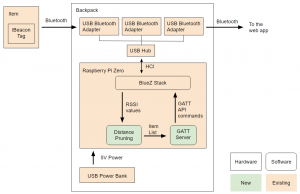This week I worked on preparing for the final presentation, and working on integrating the item recognition component into the web app. I also finalized the distance pruning algorithm and started testing the distance at which items are detected.
For the final presentation, I created a new and updated hardware block diagram to illustrate the changes that have been made since the start of our project.

The main differences are that we are no longer using the built-in Bluetooth adapter, and are instead using 3 external USB bluetooth adapters to measure RSSI values. Additionally, the task of reporting the the item list is now delegated to a separate Python GATT server running separately from the distance pruning algorithm.
As part of integrating the item recognition system, I ran into several issues deploying to AWS. Although our previous commits deployed successfully, the deployment failed as soon as we added Tensorflow to the list of required packages. Initially, I tried to rewrite the Django migration command, as I thought that was the issue from reading the error logs. However, as it turned out, I was reading the old logs from a previous failed deployment. After finding the correct error log, I realized that the AWS server was running into a memory error when installing Tensorflow. After installing Tensorflow manually with the –no-cache-dir directory set, the AWS deployment succeeded.
For this final week, I will be working on editing the final video, and preparing for the final demo. I have picked specific items to use for the final demo, and I will verify that they are detected in a practice run. Additionally, I am going to create a visualization for the distance data to use in the final report.
